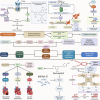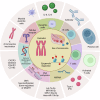Sex difference in human diseases: mechanistic insights and clinical implications
- PMID: 39256355
- PMCID: PMC11387494
- DOI: 10.1038/s41392-024-01929-7
Sex difference in human diseases: mechanistic insights and clinical implications
Abstract
Sex characteristics exhibit significant disparities in various human diseases, including prevalent cardiovascular diseases, cancers, metabolic disorders, autoimmune diseases, and neurodegenerative diseases. Risk profiles and pathological manifestations of these diseases exhibit notable variations between sexes. The underlying reasons for these sex disparities encompass multifactorial elements, such as physiology, genetics, and environment. Recent studies have shown that human body systems demonstrate sex-specific gene expression during critical developmental stages and gene editing processes. These genes, differentially expressed based on different sex, may be regulated by androgen or estrogen-responsive elements, thereby influencing the incidence and presentation of cardiovascular, oncological, metabolic, immune, and neurological diseases across sexes. However, despite the existence of sex differences in patients with human diseases, treatment guidelines predominantly rely on male data due to the underrepresentation of women in clinical trials. At present, there exists a substantial knowledge gap concerning sex-specific mechanisms and clinical treatments for diverse diseases. Therefore, this review aims to elucidate the advances of sex differences on human diseases by examining epidemiological factors, pathogenesis, and innovative progress of clinical treatments in accordance with the distinctive risk characteristics of each disease and provide a new theoretical and practical basis for further optimizing individualized treatment and improving patient prognosis.
© 2024. The Author(s).
Conflict of interest statement
The authors declare no competing interests.
Figures





Similar articles
-
Short-Term Memory Impairment.2024 Jun 8. In: StatPearls [Internet]. Treasure Island (FL): StatPearls Publishing; 2025 Jan–. 2024 Jun 8. In: StatPearls [Internet]. Treasure Island (FL): StatPearls Publishing; 2025 Jan–. PMID: 31424720 Free Books & Documents.
-
NIH Consensus Statement on Management of Hepatitis C: 2002.NIH Consens State Sci Statements. 2002 Jun 10-12;19(3):1-46. NIH Consens State Sci Statements. 2002. PMID: 14768714
-
Sex and gender as predictors for allograft and patient-relevant outcomes after kidney transplantation.Cochrane Database Syst Rev. 2024 Dec 19;12(12):CD014966. doi: 10.1002/14651858.CD014966.pub2. Cochrane Database Syst Rev. 2024. PMID: 39698949
-
Management of urinary stones by experts in stone disease (ESD 2025).Arch Ital Urol Androl. 2025 Jun 30;97(2):14085. doi: 10.4081/aiua.2025.14085. Epub 2025 Jun 30. Arch Ital Urol Androl. 2025. PMID: 40583613 Review.
-
The Black Book of Psychotropic Dosing and Monitoring.Psychopharmacol Bull. 2024 Jul 8;54(3):8-59. Psychopharmacol Bull. 2024. PMID: 38993656 Free PMC article. Review.
Cited by
-
Differential microRNA profiling of the Marshallese population in Arkansas reveals a higher association with chronic diseases.PLoS One. 2025 Aug 11;20(8):e0329321. doi: 10.1371/journal.pone.0329321. eCollection 2025. PLoS One. 2025. PMID: 40788916 Free PMC article.
-
Impaired activation of succinate-induced type 2 immunity and secretory cell production in the small intestines of Ptk6-/- male mice.Cell Death Dis. 2024 Oct 26;15(10):777. doi: 10.1038/s41419-024-07149-9. Cell Death Dis. 2024. PMID: 39461944 Free PMC article.
-
X-linked ubiquitin-specific peptidase 11 (USP11) increases susceptibility to Cushing's disease in women.Acta Neuropathol Commun. 2025 Feb 5;13(1):22. doi: 10.1186/s40478-025-01938-9. Acta Neuropathol Commun. 2025. PMID: 39910602 Free PMC article.
-
Gender differences in the association between adverse childhood experiences and early onset psoriasis.Sci Rep. 2025 Aug 5;15(1):28619. doi: 10.1038/s41598-025-12649-5. Sci Rep. 2025. PMID: 40764339 Free PMC article.
-
Clinical Characteristics, Imaging Patterns and Management in Male and Female Patients with Primary Sjögren's Syndrome-associated Interstitial Lung Disease.Clin Rheumatol. 2025 Aug 8. doi: 10.1007/s10067-025-07578-7. Online ahead of print. Clin Rheumatol. 2025. PMID: 40781169
References
Publication types
MeSH terms
Grants and funding
- 82330021/National Natural Science Foundation of China (National Science Foundation of China)
- 82061160372/National Natural Science Foundation of China (National Science Foundation of China)
- 82270771/National Natural Science Foundation of China (National Science Foundation of China)
- 82073408/National Natural Science Foundation of China (National Science Foundation of China)
LinkOut - more resources
Full Text Sources
Miscellaneous

